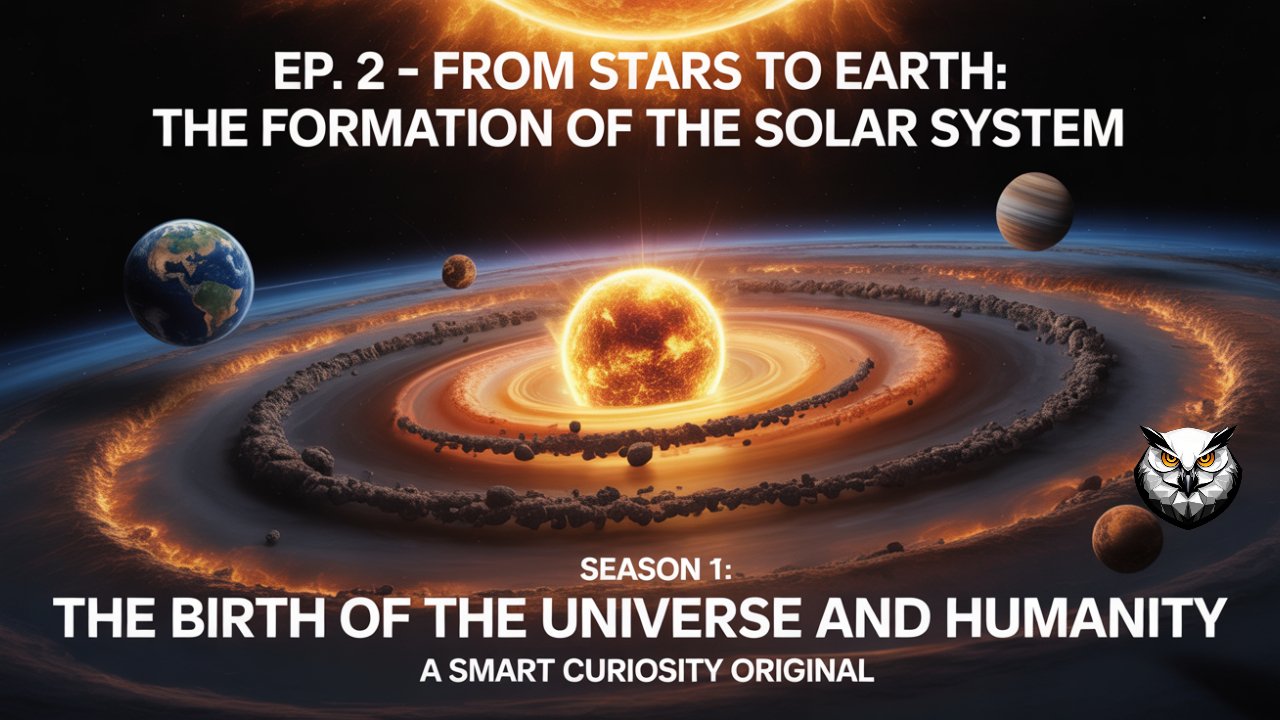For our world to be born, a star first had to die. That’s right. Our story doesn’t begin with a quiet little spark, but in the heart of a cosmic giant that lived and died long before our Sun was even a thought. In its final, explosive moments, it blasted the very elements of life across the galaxy. This is the story of how those stellar ashes gave birth to a new star, a family of planets, and one perfectly placed blue world we call home. It’s a story of impossible violence and delicate balance, of cosmic construction on a mind-boggling scale, and it’s a story that’s written into every atom in your body. To understand how we got here, we need to travel back 4.6 billion years, back through chaos and creation, to the very beginning.
Act 1: The Inheritance from the Stars
Our journey starts in a universe that would look completely alien to us. Shortly after the Big Bang, about 13.8 billion years ago, the cosmos was a pretty simple place. It was filled with almost nothing but the two lightest elements: hydrogen and helium. There was no carbon for life, no oxygen to breathe, no silicon for rocks. The ingredients for a world like Earth simply didn’t exist. For those to be made, the universe needed to build forges. It needed to build stars.
And the first stars weren’t like our sun. They were monsters leviathans of hydrogen and helium, hundreds of times more massive, burning millions of times brighter. Because they were so huge, their lives were incredibly short and violent. While our Sun will live for about ten billion years, these first-generation stars burned out in just a few million. Inside their cores, under pressures and temperatures we can barely imagine, something miraculous began: stellar nucleosynthesis.
For the first time, the universe started cooking. Intense gravity fused hydrogen into helium, helium into carbon, carbon into oxygen, and so on, climbing the periodic table. In these stellar furnaces, the fundamental building blocks of planets and life were being forged. But these precious materials were locked away deep inside. To seed the cosmos and become available for future worlds, their creators had to die.
And they died in the most spectacular way possible: a supernova. When a massive star runs out of fuel, its core collapses under its own crushing gravity. In a split second, the core implodes, rebounds, and unleashes a shockwave that tears the star apart. This explosion is one of the most energetic events in the universe, for a moment outshining an entire galaxy of a hundred billion stars.
But a supernova is more than a light show; it’s cosmic alchemy. The blast itself is so powerful it forges even heavier elements, like gold and platinum, and then launches them along with all the carbon, oxygen, and iron from the star’s core far out into space. These expanding clouds of stardust, rich with potential, are called supernova remnants. Over eons, generation after generation of massive stars lived, forged new elements, and died, each supernova enriching the galaxy a little more. They were cosmic gardeners, sowing the seeds of future worlds across the Milky Way.
Our own story begins inside one of these enriched clouds. About 4.6 billion years ago, in a quiet neighborhood of the Milky Way, a vast, cold, dark cloud of gas and dust was just… drifting. It was immense, spanning light-years across, a silent monument to countless stars that came before it. This was our molecular cloud, our stellar nursery. It held the hydrogen and helium from the Big Bang, but it was also sprinkled with those precious heavy elements from ancient supernovae the carbon, the iron, the silicon. It had everything needed to build a sun and its planets. For millions of years, this cloud was held in a delicate balance between the inward pull of gravity and the gentle outward push of its gas.
But something broke the truce. The trigger that kicked off our solar system was a nearby cosmic explosion. The prime suspect? A supernova. While scientists are still piecing together the exact details, a compelling theory suggests the shockwave from a dying star, perhaps one about 12 times the mass of our Sun, slammed into our placid cloud. This pressure wave compressed the gas and dust, creating dense pockets where gravity could finally take over. The collapse had begun. Computer models show this shockwave creating finger-like dents in the cloud, not only squeezing it but also injecting it with fresh radioactive material a kind of cosmic fingerprint we can still detect in ancient meteorites. That shockwave also gave the collapsing cloud a crucial push, imparting a gentle spin. Without that spin, everything would have just piled into the center. With it, the stage was set for a rotating disk, the very foundation of the planets.
As this piece of the cloud collapsed, it spun faster and faster think of a figure skater pulling in their arms. The vast majority of the material, over 99.8%, spiraled into the center, piling up, getting hotter and denser. This glowing, embryonic star at the heart of it all was the proto-Sun. It wasn’t a real star yet; it wasn’t hot enough for nuclear fusion. But it was the gravitational anchor of this brand-new system, and all around it, the leftovers were just beginning their own incredible journey.
Act 2: The Birth of a Star and its Family
With the glowing proto-Sun at the center, the leftover stuff less than one percent of the total mass didn’t fall straight in. Because of that initial spin, it flattened out into a huge, rotating structure: the protoplanetary disk. Picture a spinning platter of gas and dust, thousands of times wider than the Earth is from the Sun. This was the factory floor for the planets. Everything that would become Mercury, Venus, Earth, Mars, Jupiter, their moons, and all the asteroids and comets, was right here in this swirling disk.
But the disk wasn’t the same everywhere. Close to the hot proto-Sun, temperatures were scorching. Only materials with high boiling points, like rock and metal, could exist as solids. Lighter stuff, like water, methane, and ammonia, were just gas. Farther out, beyond a critical boundary we now call the “frost line,” it was cold enough for those compounds to freeze into solid ice. This simple temperature difference was the single most important factor in deciding what kind of planets would form where. It created two totally different construction zones.
In the hot inner region, planet-building started with tiny grains of dust the ashes of those ancient stars. These microscopic particles, orbiting the proto-Sun, started bumping into each other, sticking together with static electricity, like dust bunnies under your bed. Over tens of thousands of years, these specks grew into pebbles. As they got bigger, their own gravity started to help out, pulling in more particles. This process, called accretion, was a slow and steady construction project. Pebbles merged into rocks, rocks collided into boulders, and boulders smashed together to create kilometer-sized bodies called planetesimals. The inner solar system became a chaotic construction zone, swarming with trillions of these things.
The biggest planetesimals grew the fastest, their gravity becoming so strong they swept up everything in their path. Over millions of years, this process of runaway accretion formed a few dozen large bodies called protoplanets, ranging in size from our Moon to Mars. The final stage was a period of absolute mayhem, with these protoplanets crashing into each other in giant, world-shattering impacts. Eventually, the chaos subsided, leaving just the four rocky worlds we see today: Mercury, Venus, Earth, and Mars. They’re small, dense worlds made of rock and metal the only things that could solidify so close to the Sun’s furnace.
Meanwhile, out past the frost line, a completely different kind of planet was being born. Here, there wasn’t just dust, but also enormous amounts of ice. With so much more solid material to work with, the cores of the outer planets grew much, much larger than their rocky siblings, maybe ten times the mass of the entire Earth.
Once a core hit that critical mass, its gravity was so powerful it started pulling in the hydrogen and helium gas directly from the disk. This kicked off runaway gas accretion. Swirling atmospheres began to surround the huge icy-rocky cores. The two biggest, Jupiter and Saturn, became the gas giants. Their enormous gravity hoovered up unbelievable amounts of gas, making them the titans of the solar system. Jupiter, the king, ended up with more mass than all the other planets combined.
Farther out, where the disk was thinner, Uranus and Neptune grew big cores too, but they weren’t as successful in grabbing gas. They ended up with smaller atmospheres around their icy-rocky centers, becoming what we call the ice giants. Their composition is dominated by water, methane, and ammonia ices, which gives them their signature blue colors.
While all this was going on, back at the center, the proto-Sun was reaching a tipping point. After millions of years of packing on mass, the pressure and temperature in its core finally became high enough to ignite nuclear fusion. In that moment, a star was born. Our Sun lit up, becoming a young, active, and volatile T Tauri star. It immediately unleashed a powerful stellar wind, a blast of charged particles that swept out in all directions. This solar wind acted like a cosmic broom, blowing away the leftover gas and dust from the protoplanetary disk. The era of planet formation was officially over. The solar system’s basic layout was set: four small, rocky worlds inside, four giant worlds outside, all orbiting a new star. But the story was far from finished. The solar system was still a wild, chaotic place, and the most violent chapter was about to begin.
Act 3: A Habitable World and a Chaotic System
The birth of the Sun didn’t bring peace. The early solar system was an unstable shooting gallery, a long way from the orderly system we know now. The planets, especially the giants, hadn’t settled down yet. What came next was a period of dramatic upheaval, a chaotic gravitational dance that reshaped everything. Scientists explain this era with powerful ideas, most notably the Grand Tack hypothesis and the Nice Model. Though they describe different phases, together they paint a picture of a system in violent transition.
The Grand Tack hypothesis suggests that Jupiter, soon after it formed, started migrating inward. It plowed through the region where the asteroid belt is now, maybe getting as close to the Sun as Mars’s modern orbit. This journey was destructive, scattering everything in its path. It might even be why Mars is so small Jupiter could have stolen much of its building material.
But Jupiter didn’t keep going. Saturn, which was also migrating inward, started to catch up. The two giants fell into a powerful orbital resonance, where their gravitational tugs reinforced each other perfectly. This changed everything. It reversed their migration, causing both Jupiter and Saturn to “tack,” like a sailboat changing course, and start moving back out. As they moved, their gravity once again sculpted the solar system, shuffling the asteroid belt and mixing rocky bodies from the inner system with icy ones from the outer system.
That was likely the first few million years. Then, maybe 500 to 600 million years later, came the next round of chaos, described by the Nice Model. Originally, the four giant planets were probably in a much more compact arrangement. Beyond them lay a huge, dense disk of icy leftovers. Over time, slow gravitational nudges between the giants and this disk caused their orbits to shift. Jupiter moved a little bit inward, while Saturn, Uranus, and Neptune drifted outward. This slow dance eventually hit a tipping point when Jupiter and Saturn crossed a powerful resonance, where Jupiter orbited the Sun exactly twice for every one of Saturn’s orbits.
This resonance threw the entire outer solar system into chaos. The orbits of Uranus and Neptune went haywire. They were flung outwards, plowing deep into the icy disk. The havoc they created was immense, scattering trillions of comets and icy bodies everywhere. Many were hurled into the inner solar system, while others were booted out to the distant Oort Cloud or ejected from the solar system entirely. This event triggered the Late Heavy Bombardment. For about 150 million years, the inner planets, including Earth, were hammered by an intense assault of asteroids and comets, at a rate that might have been 20,000 times higher than today. The Moon’s battered face is a stark reminder of this violent time. But this bombardment wasn’t just destructive. Those icy bodies from the outer solar system were rich in water and organic compounds, and their impacts likely delivered these essential ingredients for life to a young, dry Earth.
It was during this era that one of the most important events in our planet’s history happened: the birth of the Moon. The leading theory suggests that a Mars-sized protoplanet, nicknamed Theia, slammed into the still-forming Earth. It wasn’t a head-on collision, but a glancing blow of unimaginable force. The impact melted both bodies and blasted a massive plume of vaporized rock from both Earth’s mantle and Theia into orbit. Over just a few million years, this ring of debris clumped together to form the Moon. This explains why the Moon has a tiny iron core (it’s made mostly of lighter mantle rock), why Moon rocks have the same isotopic signature as Earth rocks, and why the Earth-Moon system spins so fast. The Moon’s creation was transformative. Its gravity stabilizes Earth’s tilt, giving us the stable seasons that have been crucial for the development of complex life.
Out of this crucible of stellar death, disk chaos, and planetary migration, Earth ended up in a very special place. Its final position, sculpted by the wandering giants, landed it right in the “habitable zone” that narrow band where it’s not too hot and not too cold for liquid water to exist on a planet’s surface.
But where did all that water come from? The classic theory points to delivery by comets and water-rich asteroids during the Late Heavy Bombardment. But it’s an active debate. One newer idea suggests that a “cosmic steam bath” filled the inner solar system as the Sun heated up ice on asteroids, and Earth’s gravity simply captured the water vapor. Another theory suggests Earth’s building blocks were just naturally water-rich from the start. The jury is still out, but one way or another, the oceans arrived.
Earth’s size was also just right big enough to hold onto its water and atmosphere, but not so big it became a gas giant. As it cooled, a solid crust formed over a differentiated interior with a dense iron core. The motion in this liquid metal core generated a powerful magnetic field. This magnetic shield is our planet’s unsung hero, deflecting the Sun’s harmful solar wind and protecting our atmosphere from being stripped away, a fate that likely doomed Mars. Finally, a unique feature kicked in: plate tectonics. The constant motion of Earth’s crust acts like a planetary thermostat, recycling carbon between the atmosphere and the planet’s interior. This carbon cycle has regulated Earth’s climate for billions of years, keeping it from becoming a runaway greenhouse like Venus or a frozen wasteland like Mars.
From the death of a star to the chaotic dance of giant planets and the chance collision that gave us our Moon, an incredible sequence of events had to unfold just right. Each step was a vital link in a chain stretching back 4.6 billion years. If you found this journey through our cosmic past as amazing as we did, think about subscribing for more deep dives into the mysteries of the universe. Hit that notification bell so you don’t miss our next adventure, and let us know in the comments what origin story you want us to tackle next. Your support helps us keep telling these incredible stories.
Our story started with the ashes of a dead star. It traveled through the chaos of a spinning disk, witnessed the birth of our sun, and survived an age of cosmic bombardment. From this violent and improbable history, a perfect blue planet emerged. Every rock, every ocean, every breath of air is a product of this long and tangled cosmic story. The iron in your blood was forged in the heart of a star billions of years ago. The carbon in your cells was cooked up by stellar fusion. The water in our oceans was delivered by comets or born from the very dust that built our world. We are, quite literally, stardust. We are the universe made conscious, able to look back and piece together the incredible story of our own creation. Our journey from stars to Earth is a powerful reminder that we aren’t separate from the cosmos we are a fundamental part of it. And as we look out at the billions of other stars in our galaxy, we realize this grand process of creation is likely happening again and again, across the universe. The story isn’t over. It’s just beginning.





